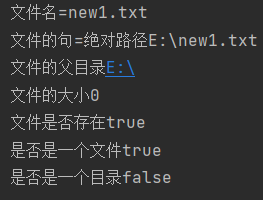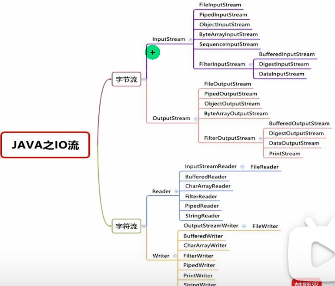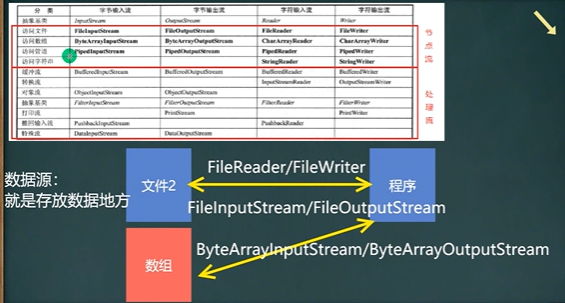Java文件与IO流
首先我们要清楚什么是流,正如其名,很形象,流就是像水一样的东西,具有方向性,在java中
,流大概就是类
接下来,我们要对输入输出流有一个基本认识,什么是输入输出流呢?
输入输出明显需要一个参照,而这个参照就是主存。
清楚了上面的概念,我们接着看下去吧。

文件
文件的创建
文件创建共有三种方式
1、
File file = new File(文件的路径);
file.createNewFile();
2、
File file = new File(文件的父目录, 文件名);
3、
File file = new File(文件的父目录, 文件的子目录);
package file;
import org.junit.jupiter.api.Test;
import java.awt.*;
import java.io.File;
import java.io.IOException;
public class FileCreate {
public static void main(String[] args) {
}
//@Test
public void create01() throws IOException {
String filePath = "E:\\new1.txt";
File file = new File(filePath);
file.createNewFile();
System.out.println("文件创建成功");
}
//@Test
public void create02() throws IOException {
File file1 = new File("E:\\");
String fileName = "new2.txt";
File file = new File(file1, fileName);
file.createNewFile();
System.out.println("文件创建成功2");
}
@Test
public void create03()
{
String FilePath = "E:\\";
String FileName = "new3.txt";
File file = new File(FilePath, FileName);
try {
file.createNewFile();
System.out.println("文件创建成功3");
} catch (IOException e) {
throw new RuntimeException(e);
}
}
}
文件信息的获取
package file;
import java.io.File;
public class FileInformation {
public static void main(String[] args) {
FileInformation fileInformation = new FileInformation();
fileInformation.info();
}
public void info()
{
File file = new File("E:\\new1.txt");
System.out.println("文件名=" + file.getName());
System.out.println("文件的句=绝对路径" + file.getAbsoluteFile());
System.out.println("文件的父目录" + file.getParentFile());
System.out.println("文件的大小" + file.length());
System.out.println("文件是否存在" + file.exists());
System.out.println("是否是一个文件" + file.isFile());
System.out.println("是否是一个目录" + file.isDirectory());
}
}

目录文件的创建和删除
删除
package file;
import com.sun.javafx.image.BytePixelSetter;
import org.junit.jupiter.api.Test;
import java.io.File;
public class Directory_ {
public static void main(String[] args) {
}
@Test
public void f1()
{
String filePath = "E:\\new1.txt";
File file = new File(filePath);
if(file.exists())
{
if(file.delete()) System.out.println("删除成功");
else System.out.println("删除成功");
}else{
System.out.println("该文件不存在");
}
}
}
目录创建
mkdir创建一级目录、mkdirs创建多级目录
@Test
public void f3()
{
String filePath = "D:\\demo\\a\\b\\c";
File file = new File(filePath);
if(file.exists())
{
System.out.println("目录存在");
}else {
if(file.mkdirs()) System.out.println("该目录创建成功");
else System.out.println("该目录创建失败");
}
}
IO流
流的分类
1、按照数据单位不同分为字节流(操作二进制的文件)和字符流(一个字符占多少个字节是不确定的这和编码有点关系,操作文本文件)
2、按流向单位不同分为输入流和输出流。
3、按流的角色分:节点流和处理流(这里角色改没有引入下面会介绍)
InputStream和OutStream、Reader、Writer是四个个抽象类,其他类均是实现的这四个Abstract类,均以他们作为后缀名


输入流
字节输入流
package inputstream;
import org.junit.jupiter.api.Test;
import java.io.FileInputStream;
import java.io.FileNotFoundException;
import java.io.IOException;
public class FileInputStream_ {
public static void main(String[] args) {
}
//@Test
public void readFile01() throws IOException {
String filePath = "D:\\hello.txt";
FileInputStream fileInputStream = null;
int readdata = 0;
try {
fileInputStream = new FileInputStream(filePath);
//返回-1表示文件读完了
while((readdata = fileInputStream.read()) != -1){
System.out.print((char) readdata);
}
} catch (IOException e) {
throw new RuntimeException(e);
}finally {
//关闭文件流
fileInputStream.close();
}
}
@Test
public void readFile02() throws IOException {
String filePath = "D:\\hello.txt";
byte[] buf = new byte[8];
FileInputStream fileInputStream = null;
int readlen = 0;
try {
fileInputStream = new FileInputStream(filePath);
//返回-1表示文件读完了
while((readlen = fileInputStream.read(buf)) != -1){
System.out.print(new String(buf, 0, readlen));
}
} catch (IOException e) {
throw new RuntimeException(e);
}finally {
//关闭文件流
fileInputStream.close();
}
}
}
字节输出流
package outputstream_;
import org.junit.jupiter.api.Test;
import java.io.FileInputStream;
import java.io.FileNotFoundException;
import java.io.FileOutputStream;
import java.io.IOException;
public class FileOutputStream01 {
public static void main(String[] args) {
}
@Test
public void writeFile() throws IOException {
String filePath = "D:\\a.txt";
FileOutputStream fileOutputStream = null;
try {
String str = "Hello World";
fileOutputStream = new FileOutputStream(filePath);
//写一个字符
// fileOutputStream.write('C');
//写一个字符串
fileOutputStream.write(str.getBytes());
} catch (IOException e) {
throw new RuntimeException(e);
}finally {
fileOutputStream.close();
}
}
}
fileOutputStream = new FileOutputStream(filePath);是覆盖
fileOutputStream = new FileOutputStream(filePath, true);是追加到源文件后
应用
package outputstream_;
import java.io.FileInputStream;
import java.io.FileNotFoundException;
import java.io.FileOutputStream;
import java.io.IOException;
public class FileCopy {
public static void main(String[] args) throws IOException {
//文件拷贝,将D:\\1.png拷贝到C:\\
//1、创建文件的输入流,将文件读入程序
//2、创建文件的输出流,将程序中的内容写入文件
String filePath = "D:\\1.jpg";
FileInputStream fileInputStream = null;
FileOutputStream fileOutputStream = null;
byte[] buf = new byte[1024];
int readlen = 0;
fileInputStream = new FileInputStream(filePath);
fileOutputStream = new FileOutputStream("E:\\1.jpg");
while((readlen = fileInputStream.read()) != -1)
{
//读取后写入文件,边读边写
fileOutputStream.write(buf, 0, readlen);
}
fileOutputStream.close();
fileInputStream.close();
}
}
FileReader
package filereader;
import java.io.FileNotFoundException;
import java.io.FileReader;
import java.io.IOException;
public class FileReader_ {
public static void main(String[] args) throws IOException {
String filePath = "D:\\a.txt";
FileReader fileReader = null;
int data = 0;
try {
fileReader = new FileReader(filePath);
while((data = fileReader.read()) != -1)
{
System.out.print((char) data);
}
} catch (FileNotFoundException e) {
throw new RuntimeException(e);
} catch (IOException e) {
throw new RuntimeException(e);
} finally {
fileReader.close();
}
}
}
用字符数组来读
package filereader;
import org.junit.jupiter.api.Test;
import java.io.FileNotFoundException;
import java.io.FileReader;
import java.io.IOException;
public class FileReader_ {
public static void main(String[] args){
}
@Test
public void readFile01() throws IOException {
String filePath = "D:\\a.txt";
int readlen = 0;
FileReader fileReader = null;
char [] buf = new char[8];
try {
fileReader = new FileReader(filePath);
while((readlen = fileReader.read(buf)) != -1)
{
System.out.print(new String(buf, 0, readlen));
}
} catch (FileNotFoundException e) {
throw new RuntimeException(e);
} catch (IOException e) {
throw new RuntimeException(e);
} finally {
fileReader.close();
}
}
}
FileWriter
写入数据之后一定要关流或者刷新数据才能被写入
package filewrite;
import java.io.FileWriter;
import java.io.IOException;
public class FileWriter_ {
public static void main(String[] args) {
String path = "D:\\a.txt";
FileWriter fileWriter = null;
try {
fileWriter = new FileWriter(path, true);
fileWriter.write("aaaa");
} catch (IOException e) {
throw new RuntimeException(e);
}finally {
try {
fileWriter.close();
} catch (IOException e) {
throw new RuntimeException(e);
}
}
}
}
节点流和处理流
处理流是连接在已存在的流之上为程序提供更强大的读写功能,包装流更加形象

BufferedReader & BufferedWriter
package BufferedReader_;
import javax.swing.text.Style;
import java.io.BufferedReader;
import java.io.FileNotFoundException;
import java.io.FileReader;
import java.io.IOException;
public class BufferedReader_ {
public static void main(String[] args) throws IOException {
String path = "D:\\a.txt";
BufferedReader bufferedReader = new BufferedReader(new FileReader(path));
String line;
try {
//bufferedReader.readLine();按行读取,当读取到空时,表示读取结束
while((line = bufferedReader.readLine()) != null) System.out.println(line);;
} catch (FileNotFoundException e) {
throw new RuntimeException(e);
} catch (IOException e) {
throw new RuntimeException(e);
}finally {
bufferedReader.close();
}
}
}
package bufferedreader;
import java.io.*;
public class BufferedReader_ {
public static void main(String[] args) throws IOException {
String path = "D:\\a.txt";
BufferedWriter bufferedWriter = new BufferedWriter(new FileWriter(path, true));
try {
bufferedWriter.write("阿杜吃饱饱");
} catch (IOException e) {
throw new RuntimeException(e);
}finally {
bufferedWriter.flush();
}
}
}
视频、图片等是二进制文件用字节流更方便
对象流
使用细节
1、读写顺序要一致
2、要求实现序列化或反序列化对象,需要实现Serializable
3、序列化默认是将所有属性都序列化,但是static和transient不序列化
4、序列化里面的属性也要是现实Serializable接口
标准输入输出流
转换流
转换流应用的情况:
因为字符流不能指定编码格式,而字节流可以指定编码格式,可以先按字节流读入,再用转换流转化,这样就不会乱码了


【推荐】国内首个AI IDE,深度理解中文开发场景,立即下载体验Trae
【推荐】博客园2025新款「AI繁忙」系列T恤上架,前往周边小店选购
【推荐】凌霞软件回馈社区,携手博客园推出1Panel与Halo联合会员
【推荐】轻量又高性能的 SSH 工具 IShell:AI 加持,快人一步